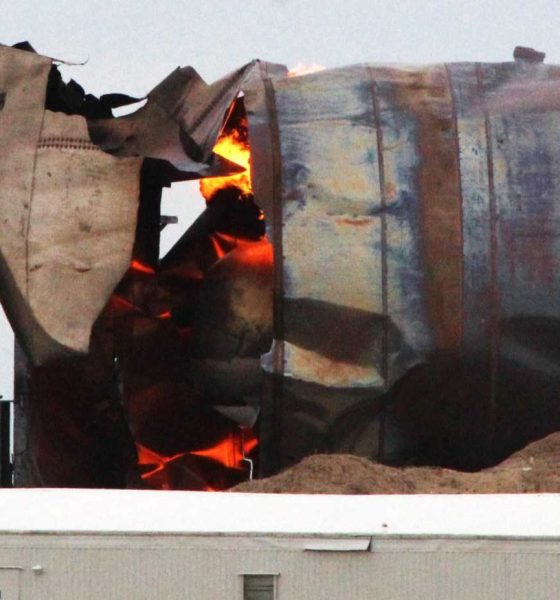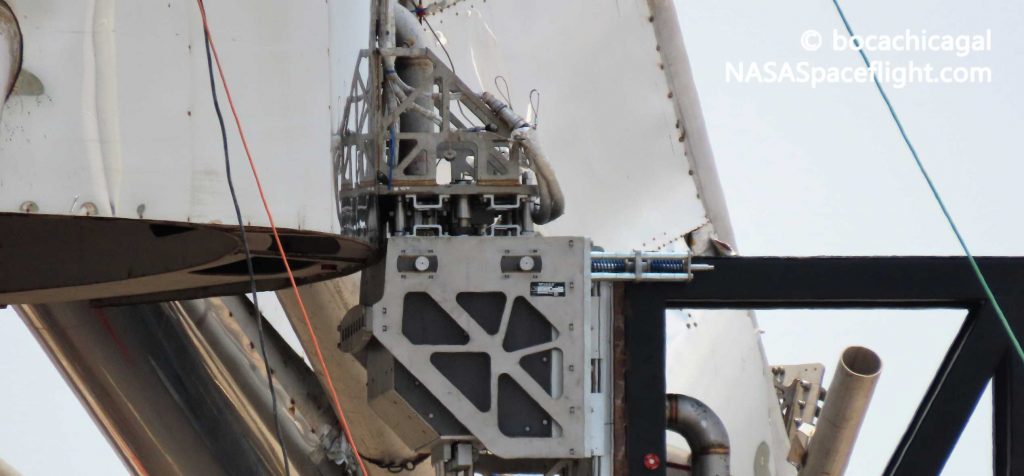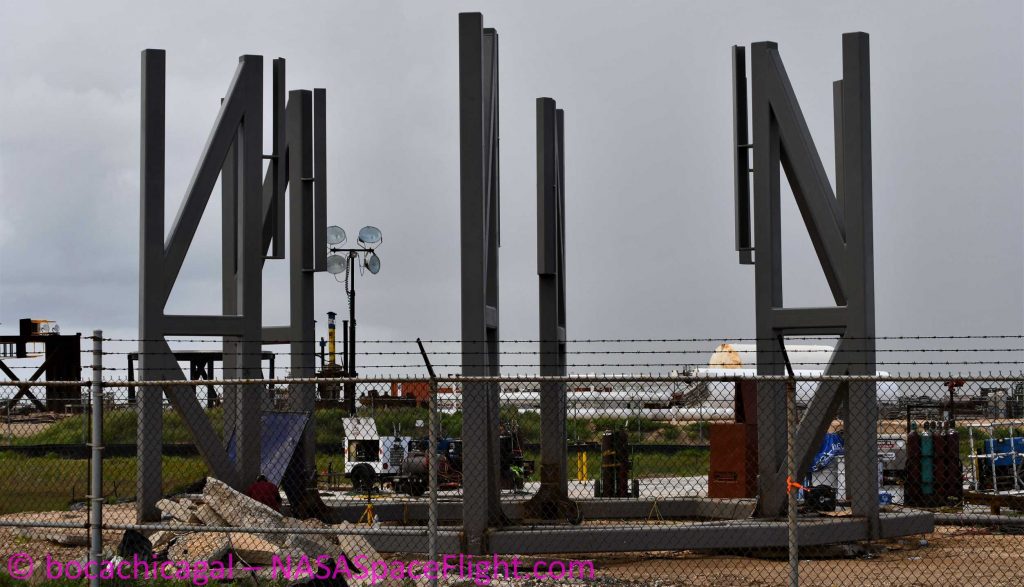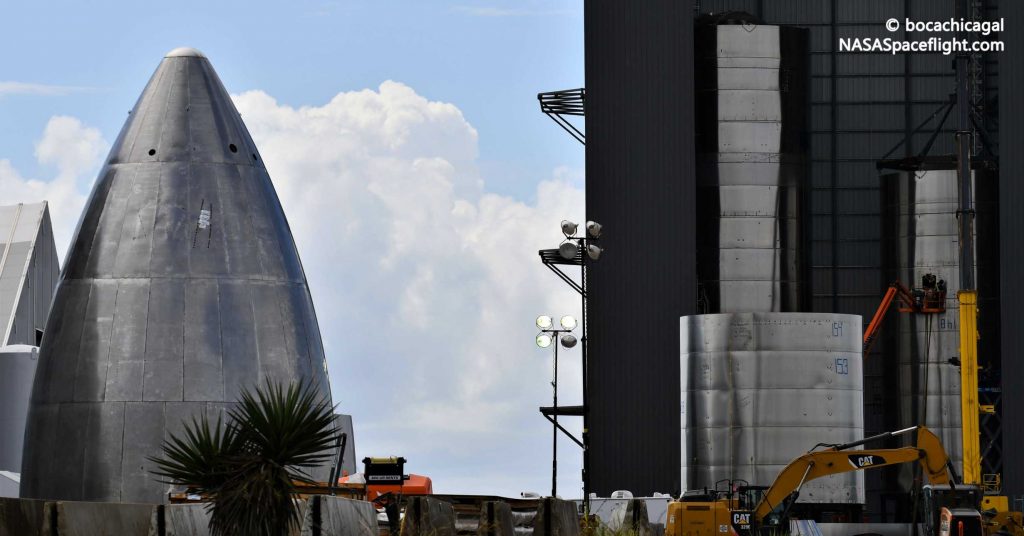

News
SpaceX’s Starship explosion explained by Elon Musk
Shortly after a briefing following SpaceX’s flawless astronaut launch debut, CEO Elon Musk casually revealed the best explanation yet for why a Starship prototype violently exploded during testing on May 29th.
On that fated Saturday, SpaceX successfully completed the fifth static fire of a Raptor engine installed on a full-scale Starship prototype, preceded by about an hour and a half of vehicle checks and propellant loading. Unfortunately, around a minute after Raptor shut down, what was quickly identified as liquid methane began spurting out of a specific section at the base of Starship, rapidly creating a massive cloud as the cryogenic propellant boiled and turned into gas. The specific source is unclear but moments later, something under Starship SN4 provided the shock or spark needed to ignite the expanding fire hazard, producing a spectacularly large and violent explosion.
Unsurprisingly, the accidental fuel-air explosion that was created obliterated Starship SN4 in the blink of an eye, shredding its lower (liquid oxygen) tank into steel confetti and immediately breaching the upper (liquid methane) tank, which fell to the ground and subsequently exploded again. The launch mount Starship was staged on was also damaged beyond repair and has been fully dismantled and scrapped in the two days since the anomaly. Thankfully, however, SpaceX already has replacement mounts and ships well on their way to carrying Starship SN4’s torch forward and Elon Musk already seems to understand what caused the prototype’s demise.
Shortly after a post-launch briefing celebrating and discussing SpaceX’s inaugural astronaut launch on May 30th, Reuters reporter Joey Roulette was able to ask Musk about Starship SN4’s spectacular demise the day prior. The SpaceX CEO was quoted saying that “what we thought was going to be a minor test of a quick disconnect ended up being a big problem”, confirming suspicions based on careful analysis of public views of the explosion that it was caused by issues with Starship’s ground support equipment (GSE).

In Musk’s statement, “quick disconnect” (QD) refers to an umbilical port that connects a launch vehicle to GSE, enabling the loading and offloading of propellant and fluids, clamping down the rocket, and providing a wired telemetry and communications link for ground controllers. QDs must perform all those tasks while also being able to rapidly release and disconnect, allowing the rocket to lift off while still protecting its sensitive ports for ease of reuse.
In theory, Starship’s quick-disconnect umbilical panel is even more complex, as it will have to simultaneously enable the ship to be fueled and controlled while sitting on top of a Super Heavy booster and permit in-orbit docking and refueling. Given that Starships are currently being tested independently on spartan launch mounts, it’s unclear if the current generation of prototypes has been outfitted with advanced QD panels. More likely, Musk was referring to a test of a less advanced QD panel similar to the rough version used on Starhopper last year, and SpaceX simply wanted to test its ability to disconnect and reconnect to Starship on command.


If that’s the case, the likeliest explanation for SN4’s explosion is that that quick disconnect was unable to fully reconnect after the test, resulting in a leak from the liquid methane port when SpaceX began to detank the rocket. Instead of the highly-pressurized fluid flowing smoothly back to ground storage tanks, the liquid methane sprayed wildly, akin to the effect one might observe when attempting to block off an active water source with an open palm.


Compared to the many possible ways a fueled Starship could fail, a propellant leak started by a faulty umbilical panel is about as convenient as they come. Starship SN4 may have been violently destroyed as a result, turning a relatively small error into exceptionally painful lesson but SpaceX has already had some success building full-scale prototypes at an almost unbelievably low cost – likely less than $10M apiece. Starship SN5 appears to be just shy of ready to take SN4’s place on the launch mount, although SpaceX will have to build an entirely new launch mount before it can resume testing.
At the same time, Starship SN5’s successor – SN6 – is just one stacking event away from reaching a level of completion similar to SN4 and SN5. All told, Starship SN4’s demise is just another part of the process of developing a new kind of rocket by building and testing hardware – failure can be a valuable tool when managed properly. Based on past observations, SpaceX could be ready to continue testing (and hopefully flying) Starship prototypes before the end of the month.
Check out Teslarati’s Marketplace! We offer Tesla accessories, including for the Tesla Cybertruck and Tesla Model 3.

Cybertruck
Tesla Cybertruck undergoes interior mod that many owners wanted

Tesla Cybertruck is significantly different from traditional pickups on the market in a lot of ways. However, one feature that was recently modified with its interior was a highly requested characteristic that is present in other trucks, but was void from Cybertruck.
Tesla went with a five-seat configuration with Cybertruck: two in the front and three in the back. The spacious interior is matched with plenty of storage, especially up front, as a pass-through, center console, and other storage options, but some Tesla fans wanted something different: bench seating.
Bench seating is popular in many full-size pickups and allows three passengers to sit up front. The middle seat is usually accompanied by a fold-down storage unit with cupholders.
Tesla decided to opt for no bench seating up front, despite the fact that it equipped bench seating in the unveiling in 2019. Interior photos from the unveiling event from nearly six-and-a-half years ago show Tesla had originally planned to have a six-seat configuration.
This was adjusted after the company refined the design:

(Tesla Cybertruck interior configuration in 2019)
Despite Tesla abandoning this design, it does not mean owners were willing to accept it. One owner decided to modify their Tesla Cybertruck interior to equip that third seat between the driver’s and passenger’s thrones.
The fit is snug, and while it looks great, it is important to remember that this does not abide byregulations, as it would require an airbag to be technically legal. Please do not do this at home with your own Cybertruck:
- Credit: @blueskykites
- Credit: @blueskykites
- Credit: @blueskykites
The Cybertruck is a popular vehicle in terms of publicity, but its sales have been underwhelming since first delivered to customers back in 2023. It’s hard to believe it’s been out for two-and-a-half years, but despite this, Tesla has not been able to come through on its extensive order sheet.
This is mostly due to price, as Cybertruck was simply not as affordable as Tesla originally planned. Its three configurations were initially priced at $39,990, $49,990, and $69,990. At release, Cybertruck was priced above $100,000.
This priced out many of those who had placed orders, which is the main reason Cybertruck has not lived up to its expectations in terms of sales. The adjustments to the specific features, like the removal of the bench seat, likely did not impact sales as much as pricing did.
This modification shows some creativity by Tesla owners, but also shows that the Cybertruck could always be the subject of a potential refresh to include some of these features. Tesla routinely adjusts its vehicle designs every few years, so maybe the Cybertruck could get something like this if it chooses to refresh its all-electric pickup.
Elon Musk
Tesla CEO Elon Musk drops massive bomb about Cybercab
“And there is so much to this car that is not obvious on the surface,” Musk said.

Tesla CEO Elon Musk dropped a massive bomb about the Cybercab, which is the company’s fully autonomous ride-hailing vehicle that will enter production later this year.
The Cybercab was unveiled back in October 2024 at the company’s “We, Robot” event in Los Angeles, and is among the major catalysts for the company’s growth in the coming years. It is expected to push Tesla into a major growth phase, especially as the automaker is transitioning into more of an AI and Robotics company than anything else.
The Cybercab will enable completely autonomous ride-hailing for Tesla, and although its other vehicles will also be capable of this technology, the Cybercab is slightly different. It will have no steering wheel or pedals, and will allow two occupants to travel from Point A to Point B with zero responsibilities within the car.
Tesla shares epic 2025 recap video, confirms start of Cybercab production
Details on the Cybercab are pretty face value at this point: we know Tesla is enabling 1-2 passengers to ride in it at a time, and this strategy was based on statistics that show most ride-hailing trips have no more than two occupants. It will also have in-vehicle entertainment options accessible from the center touchscreen.
It will also have wireless charging capabilities, which were displayed at “We, Robot,” and there could be more features that will be highly beneficial to riders, offering a full-fledged autonomous experience.
Musk dropped a big hint that there is much more to the Cybercab than what we know, as a post on X said that “there is so much to this car that is not obvious on the surface.”
And there is so much to this car that is not obvious on the surface
— Elon Musk (@elonmusk) January 2, 2026
As the Cybercab is expected to enter production later this year, Tesla is surely going to include a handful of things they have not yet revealed to the public.
Musk seems to be indicating that some of the features will make it even more groundbreaking, and the idea is to enable a truly autonomous experience from start to finish for riders. Everything from climate control to emergency systems, and more, should be included with the car.
It seems more likely than not that Tesla will make the Cybercab its smartest vehicle so far, as if its current lineup is not already extremely intelligent, user-friendly, and intuitive.
Investor's Corner
Tesla Q4 delivery numbers are better than they initially look: analyst
The Deepwater Asset Management Managing Partner shared his thoughts in a post on his website.

Longtime Tesla analyst and Deepwater Asset Management Managing Partner Gene Munster has shared his insights on Tesla’s Q4 2025 deliveries. As per the analyst, Tesla’s numbers are actually better than they first appear.
Munster shared his thoughts in a post on his website.
Normalized December Deliveries
Munster noted that Tesla delivered 418k vehicles in the fourth quarter of 2025, slightly below Street expectations of 420k but above the whisper number of 415k. Tesla’s reported 16% year-over-year decline, compared to +7% in September, is largely distorted by the timing of the tax credit expiration, which pulled forward demand.
“Taking a step back, we believe September deliveries pulled forward approximately 55k units that would have otherwise occurred in December or March. For simplicity, we assume the entire pull-forward impacted the December quarter. Under this assumption, September growth would have been down ~5% absent the 55k pull-forward, a Deepwater estimate tied to the credit’s expiration.
“For December deliveries to have declined ~5% year over year would imply total deliveries of roughly 470k. Subtracting the 55k units pulled into September results in an implied December delivery figure of approximately 415k. The reported 418k suggests that, when normalizing for the tax credit timing, quarter-over-quarter growth has been consistently down ~5%. Importantly, this ~5% decline represents an improvement from the ~13% declines seen in both the March and June 2025 quarters.“
Tesla’s United States market share
Munster also estimated that Q4 as a whole might very well show a notable improvement in Tesla’s market share in the United States.
“Over the past couple of years, based on data from Cox Automotive, Tesla has been losing U.S. EV market share, declining to just under 50%. Based on data for October and November, Cox estimates that total U.S. EV sales were down approximately 35%, compared to Tesla’s just reported down 16% for the full quarter. For the first two months of the quarter, Cox reported Tesla market share of roughly a 65% share, up from under 50% in the September quarter.
“While this data excludes December, the quarter as a whole is likely to show a material improvement in Tesla’s U.S. EV market share.“











